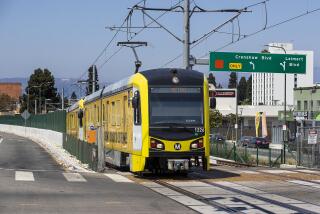A Dozen Options for Easing Gridlock
- Share via
Facing increased truck traffic on an already congested corridor, a coalition of government agencies Tuesday offered a dozen options for the Long Beach Freeway, including adding elevated truck lanes, carpool lanes and a high-speed rail line.
Cost estimates were not included with the 12 alternatives, which were developed for a group of state transportation officials and local policymakers along Interstate 710. A committee of local officials is expected to narrow the options to five finalists by June before choosing the final plan next spring. Officials expect to release cost estimates when the five finalists are announced.
Some of the alternatives--such as the option to add a rail line along the freeway median--would be expensive. But local officials say a fix is vital to improve traffic flow in the region.
“Although improvements to the Long Beach Freeway are badly needed and long overdue, some of the proposed alternatives will not be easy to implement and funding is still an open question,” said South Gate City Councilman Hector De La Torre, chairman of the committee that is studying the options.
Ultimately, the alternative selected by the committee would probably need funding approval by a state or regional transit agency such as the Metropolitan Transportation Authority or the California Transportation Commission.
Transportation experts say some of the alternatives could be financed with tolls for truckers or commuters.
The 710 was designed in the 1950s, assuming trucks would represent only 5% of the traffic. But today, the freeway is a major route for trucks hauling cargo between the ports of Los Angeles and Long Beach and distribution centers near East Los Angeles. Big rigs represent about 13% of the freeway’s traffic.
Even more trucks are expected in the future. The ports now generate about 34,000 daily truck trips. But according to one estimate, that number will nearly triple by 2020 because of increased trade with Pacific Rim countries.
The mixture of rush-hour traffic and cargo-hauling trucks can be a deadly combination. In 2001, the freeway had 616 collisions involving trucks, including an 11-vehicle pileup in January that killed a judge and injured nine others when a big-rig driver lost control near the city of Bell.
“There is room for improvements, definitely,” said Margaret Peterson, a truck driver for 24 years and a safety specialist who regularly hauls cargo along the Long Beach Freeway.
The 12 alternatives, designed by the engineering firm of Parsons Brinckerhoff, Quade & Douglas Inc. with suggestions from local officials and residents, focus on the stretch of freeway between the ports and the Pomona Freeway.
The alternatives are:
* Do nothing beyond the pavement and median improvements already underway.
* Encourage the ports and truck drivers to shift their schedules to keep trucks off the freeway during heavy commute hours.
* Improve freeway ramps and widen adjacent roads by eliminating some on-street parking. Many cloverleaf-shaped ramps bring traffic to a crawl because truckers cannot easily navigate the narrow, sharp curves.
* Improve freeway interchanges and add truck-only connector ramps in some locations.
* Build one carpool lane along the median in each direction.
* Add a fifth traffic lane in each direction between the ports and the San Diego Freeway and between Imperial Highway and Atlantic Boulevard.
* Build special “truck bypass lanes” that allow truckers to avoid congestion at the interchanges with the San Diego, Artesia and Century freeways.
* Add two traffic lanes in each direction between the ports and the San Diego Freeway and between Imperial Highway and Atlantic Boulevard. The rest of the freeway would get one additional lane in each direction.
* Add two elevated truck lanes in each direction along the median of the freeway.
* Build two special-purpose lanes--possibly toll lanes--in each direction along the median.
* Add two elevated carpool lanes in each direction along the median.
* Add a high-speed rail line along the median. The rail line would divert from the freeway in South Gate and run along an existing rail line to Union Station in downtown Los Angeles.
More to Read
Sign up for Essential California
The most important California stories and recommendations in your inbox every morning.
You may occasionally receive promotional content from the Los Angeles Times.











